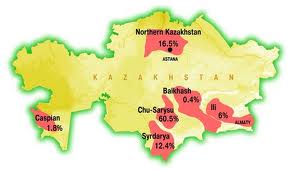Uranium is a common element. It forms compounds with many other elements and is present in a wide variety of minerals. Four common geological processes distribute uranium minerals in many different forms across the earth. Only a few of the many minerals are considered suitable for extraction to obtain useful uranium and only a few of their deposits are currently exploited. .About one third of the worlds uranium resources are in the form of unconformity-related deposits. Another quarter are found in sedimentary sandstone deposits.
The biggest producer of uranium in the world is the Central Asian country of Kazakhstan which used to be part of the Soviet Union. It contains about one fifth of the explored uranium reserves on Earth and produces about 36% of the world’s mined uranium. The deposits were formed by a variety of processes including sedimentation, veins, phosphorite, lignite, and oxidation mineralization. There are is a major deposit in the north, a deposit in the west near the Caspian Sea and four major deposits in the south east of the country.
Canada accounts for 17% percent of the uranium mined in the world. All of Canada’s uranium production comes from unconformity-related deposits at McClean Lake and McArthur River in the Atahbasca Basin of Saskatchewan in the far north. A third deposit being developed in that area near Cigar Lake is the largest undeveloped high-grade deposit in the world.
The majority of Australia’s 11% share of world uranium production is taken from the breccia complex deposit at Olympic Dam in Southern Australia. Australia also extracts uranium from big deposits of the unconformity-related type in the Alligator Rivers area of the Northern territories and the Rudall River area of Western Australia.
Niger in is a large landlocked mostly desert country in Western Africa which provides 8% of the world’s mined uranium. The principle deposits are the sandstone type and are located in the north east of the country near the Sahara desert.
Namibia produces around 6% of the world’s uranium. It is near the southern tip of Africa on the Atlantic Coast. Magmatic processes created the Namibia uranium deposits.
Russian mines produce 5.5% of the uranium extracted from the world’s mines. Volcanic processes were a major generator of the Russian deposits. The principle deposits of uranium being mined in Russia is in the Krasnokamensky District of Zabaykalsky Krai in the far East on the border with Mongolia and China.
Uzbekistan is another of the Central Asian countries that used to be part of the Soviet Union. It is locate east of the Caspian Sea south of Kazakhstan. Uranium deposits are of the sandstone and black shale variety and Uzbek mines produce 4.5% of the world’s uranium production.
The United States extracts most of its 3% of the world’s mined uranium from sandstone deposits in what is referred to as the Western Cordillera region which extends all the way from Alaska to Mexico and covers the western part of the U.S. from the Rocky Mountains to the Pacific Coast. The Powder River Basin in Wyoming, the Colorado Plateau and the Gulf Coast Plain in Texas also contain uranium bearing sandstone deposits.
The eight countries listed above account for over 91% of the annual uranium mine production in the world. Ukraine, China, Malawi, South Africa, India, Brazil, Czech Republic, Romania, Germany, Pakistan and France together account for 8% of the mined uranium in the world.
